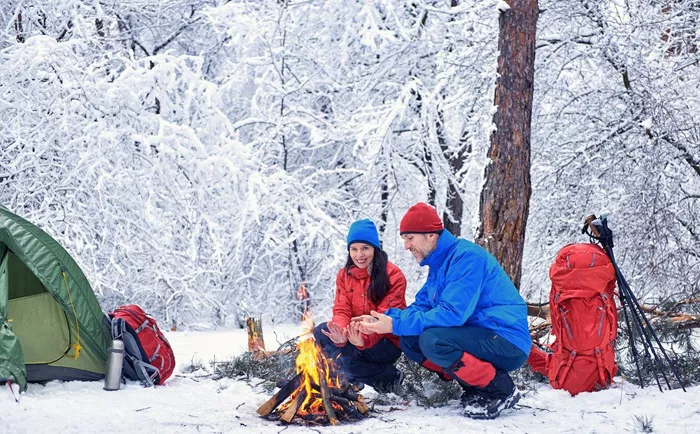Winter camping might sound crazy to some, but for outdoor lovers, it’s an exciting adventure. Cold weather, snow-covered landscapes, and quiet forests create a unique experience. But is winter camping really fun? Let’s explore this question in detail.
Why Try Winter Camping?
Winter camping offers several benefits that summer camping can’t match. Here are some reasons why people love it:
- Fewer crowds: Most campers stay home when it gets cold, so you’ll have nature mostly to yourself.
- Beautiful scenery: Snow transforms familiar landscapes into magical winter wonderlands.
- New challenges: Winter camping tests your skills and knowledge in ways summer camping doesn’t.
- Unique activities: You can try snowshoeing, ice fishing, or building snow shelters.
Essential Winter Camping Gear
Having the right equipment makes winter camping safer and more enjoyable. Here’s what you need:
Shelter and Sleeping System
- Four-season tent: These tents are stronger and better at keeping heat in than summer tents.
- Warm sleeping bag: Look for one rated at least 10°F lower than the coldest expected temperature.
- Sleeping pad: Use two pads – one closed-cell foam and one inflatable – for maximum insulation.
Clothing Layers
Dressing properly is crucial for winter camping comfort:
- Base layer: Moisture-wicking fabric like merino wool keeps sweat away from your skin.
- Mid layer: Fleece or down provides insulation.
- Outer layer: Waterproof and windproof shell protects against the elements.
Other Important Gear
- Stove: Liquid fuel stoves work better in cold than canister stoves.
- Water bottles: Wide-mouth bottles prevent freezing shut (insulate them too).
- Headlamp: Cold drains batteries faster, so bring extras.
- Trekking poles: Helpful for stability in snow.
Winter Camping Skills You Need
Winter camping requires some special knowledge:
Staying Warm
- Eat often: Your body burns more calories staying warm in cold weather.
- Stay dry: Wet clothing loses insulation value quickly.
- Move smart: Avoid sweating by removing layers before you get too hot.
Setting Up Camp
- Choose protected spots: Look for natural windbreaks like trees or hills.
- Pack down snow: Walk on your tent site before setting up to create a firm base.
- Ventilate your tent: Prevents condensation from your breath freezing inside.
Fire Starting
- Bring dry tinder: Store it in waterproof containers.
- Use fire starters: Commercial starters or homemade ones work well.
- Protect from wind: Build a windbreak or dig a shallow pit for your fire.
Fun Winter Camping Activities
Winter opens up possibilities for unique fun:
Snow Sports
- Snowshoeing: Lets you walk on deep snow without sinking.
- Cross-country skiing: Great exercise and way to explore.
- Sledding: Bring a small sled for fun and hauling gear.
Ice Fishing
With proper ice safety knowledge, ice fishing can provide food and entertainment.
Winter Photography
The low winter sun creates beautiful lighting for landscape photos.
Shelter Building
Practice making quinzees (snow huts) or igloos for fun and emergency skills.
Safety Considerations
Winter camping has more risks than summer camping. Stay safe by:
Watching the Weather
- Check forecasts: Winter storms can be dangerous.
- Know signs of hypothermia: Shivering, confusion, slurred speech.
- Understand frostbite: White or grayish-yellow skin patches are warning signs.
Travel Precautions
- Daylight is short: Plan activities accordingly.
- Snow covers trails: GPS or map skills become more important.
- Stream crossings: Ice may not be thick enough to support weight.
Emergency Preparedness
- Tell someone your plans: Include route and return time.
- Bring extra food: In case you get stuck longer than planned.
- Carry emergency shelter: Even if just a space blanket.
Making Winter Camping Comfortable
Small touches can make winter camping more enjoyable:
Campsite Comforts
- Camp chairs: Bring insulated ones or use sleeping pads as seats.
- Hot drinks: Tea, cocoa, or cider warm you from the inside.
- Games/cards: Good for long nights in the tent.
Sleeping Warm
- Heat water bottles: Fill with warm water and put in your sleeping bag.
- Change clothes: Wear dry sleep-specific base layers.
- Eat before bed: Your body generates heat digesting food.
Where to Go Winter Camping
Great winter camping spots include:
National Parks
Many national parks allow winter camping with fewer restrictions than summer.
Designated Winter Campgrounds
Some campgrounds stay open year-round with maintained winter facilities.
Backcountry Areas
With proper permits and skills, wilderness areas offer solitude.
Common Winter Camping Mistakes to Avoid
Learn from others’ errors:
- Underestimating conditions: Winter weather changes fast.
- Overpacking: Heavy loads tire you faster in snow.
- Skipping layers: Think you don’t need all that clothing? You probably do.
- Poor hydration: Cold air is dry – drink more than you think you need.
Conclusion
For prepared adventurers, winter camping can be incredibly rewarding. The quiet beauty of snow-covered landscapes, the satisfaction of mastering cold-weather skills, and the unique activities available make it special. While more challenging than summer camping, that’s part of the appeal for many outdoor enthusiasts.
The key is proper preparation – having the right gear, knowledge, and attitude transforms winter camping from miserable to magical. Start with short trips close to home to build skills and confidence. Many people who try winter camping find it becomes their favorite way to experience the outdoors.
Would I call winter camping fun? Absolutely – if you approach it with respect for the conditions and a sense of adventure. The memories made around a winter campfire or waking up to frosted trees are unlike any summer camping experience. Give it a try – you might discover a new passion!
Related topics:
What Do I Need for Winter Camping?
Best Winter Camping Gear: A Complete Guide

